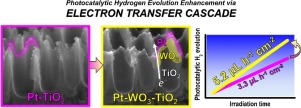Applied Catalysis B: Environment and Energy ( IF 20.2 ) Pub Date : 2018-05-22 , DOI: 10.1016/j.apcatb.2018.05.061 Davide Spanu , Sandro Recchia , Shiva Mohajernia , Patrik Schmuki , Marco Altomare

|
Among several parameters that affect the yield of a photocatalytic process mediated by a metal oxide semiconductor, key is the efficient separation and transfer of photo-generated charge carriers. To overcome kinetic limitations and enable charge transfer, an effective strategy is to decorate the photocatalyst surface with cocatalytic nanoparticles of either a second semiconductor metal oxide or a noble metal. Nevertheless, classical deposition techniques based on powder technology approaches lead to randomly placed cocatalytic nanoparticles at the photocatalytic surface. The poor control over cocatalyst placement can drastically hamper the photocatalytic efficiencies, and can also prevent a full understanding of the charge carrier dynamics and photocatalytic mechanism. Here we investigate a highly defined charge separation platform for photocatalytic H2 evolution based on a Pt-WO3-TiO2 “stacked” structure constructed on anodically grown TiO2 nanotube arrays. Key is the formation of a site-selective and sequential W and Pt metal sputter-decoration only at the mouth of highly-ordered TiO2 nanotubes. After placing the W-Pt bilayer at the nanotubes mouth, a suitable thermal treatment forms a WO3 layer atop the nanotubes while the Pt film undergoes solid state dewetting into 2–6 nm-sized Pt nanoparticles. These structures show strongly improved photocatalytic H2 evolution efficiency compared to any other single-cocatalyst system (Pt-TiO2 and WO3-TiO2) and pristine TiO2 nanotubes. The photocatalytic activity improvement is ascribed to an enhanced charge carrier separation mechanism enabled by the well-defined TiO2-WO3-Pt architecture that provides swift electron transfer through WO3 and towards Pt for H2 evolution.
中文翻译:

WO 3包覆的TiO 2纳米管阵列上的定点Pt脱湿:基于电子转移级联的H 2析出光催化剂
在影响由金属氧化物半导体介导的光催化过程的产率的几个参数中,关键是光生电荷载流子的有效分离和转移。为了克服动力学限制并实现电荷转移,有效的策略是用第二种半导体金属氧化物或贵金属的助催化纳米颗粒修饰光催化剂表面。然而,基于粉末技术方法的经典沉积技术导致将共催化纳米颗粒随机放置在光催化表面上。对助催化剂放置的控制不当会极大地阻碍光催化效率,并且还会妨碍对电荷载流子动力学和光催化机理的全面了解。2基于在阳极生长的TiO 2纳米管阵列上构建的Pt-WO 3 -TiO 2 “堆叠”结构的演变。关键是仅在高度有序的TiO 2纳米管的口部形成定点和连续的W和Pt金属溅射修饰。将W-Pt双层置于纳米管口后,适当的热处理会在纳米管顶部形成WO 3层,同时Pt膜会进行固态去湿润,形成2–6 nm大小的Pt纳米颗粒。与任何其他单助催化剂体系(Pt-TiO 2和WO 3 -TiO 2)相比,这些结构均显示出大大提高的光催化H 2释放效率。)和原始的TiO 2纳米管。光催化活性的提高归因于完善的TiO 2 -WO 3 -Pt体系结构所实现的增强的电荷载流子分离机制,该体系提供了通过WO 3向Pt的快速电子转移,从而促进了H 2的释放。











































 京公网安备 11010802027423号
京公网安备 11010802027423号